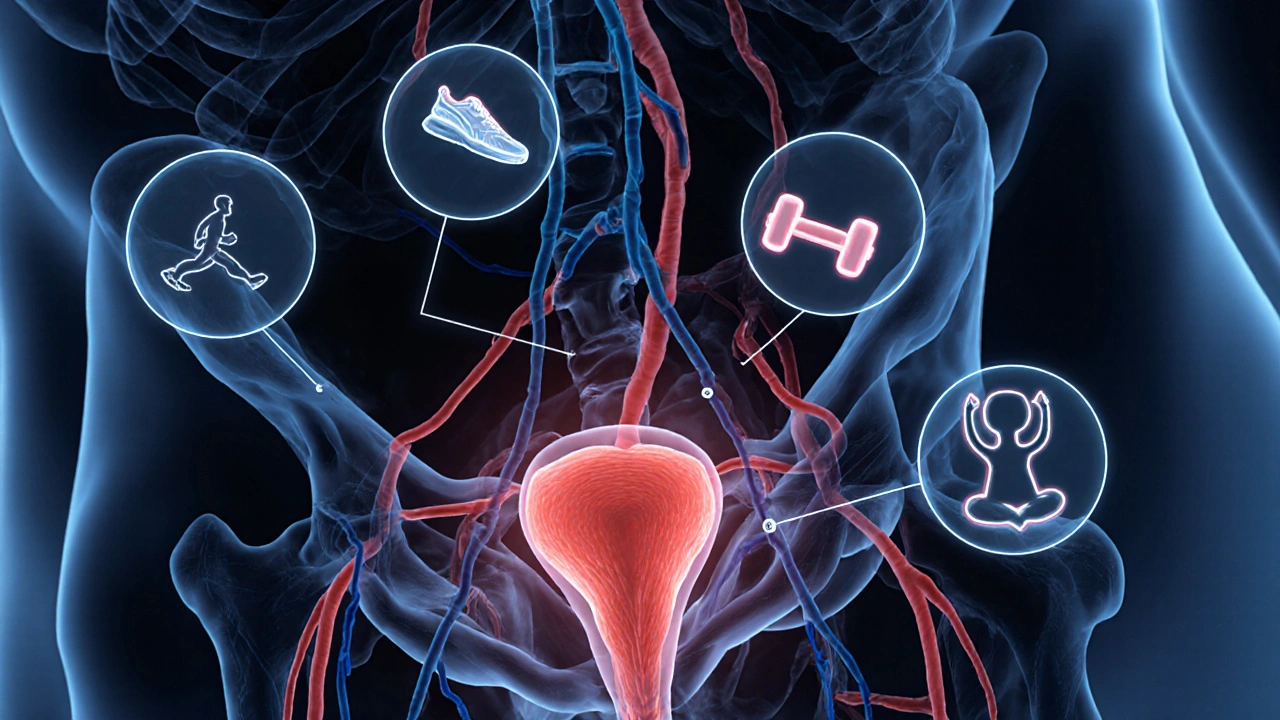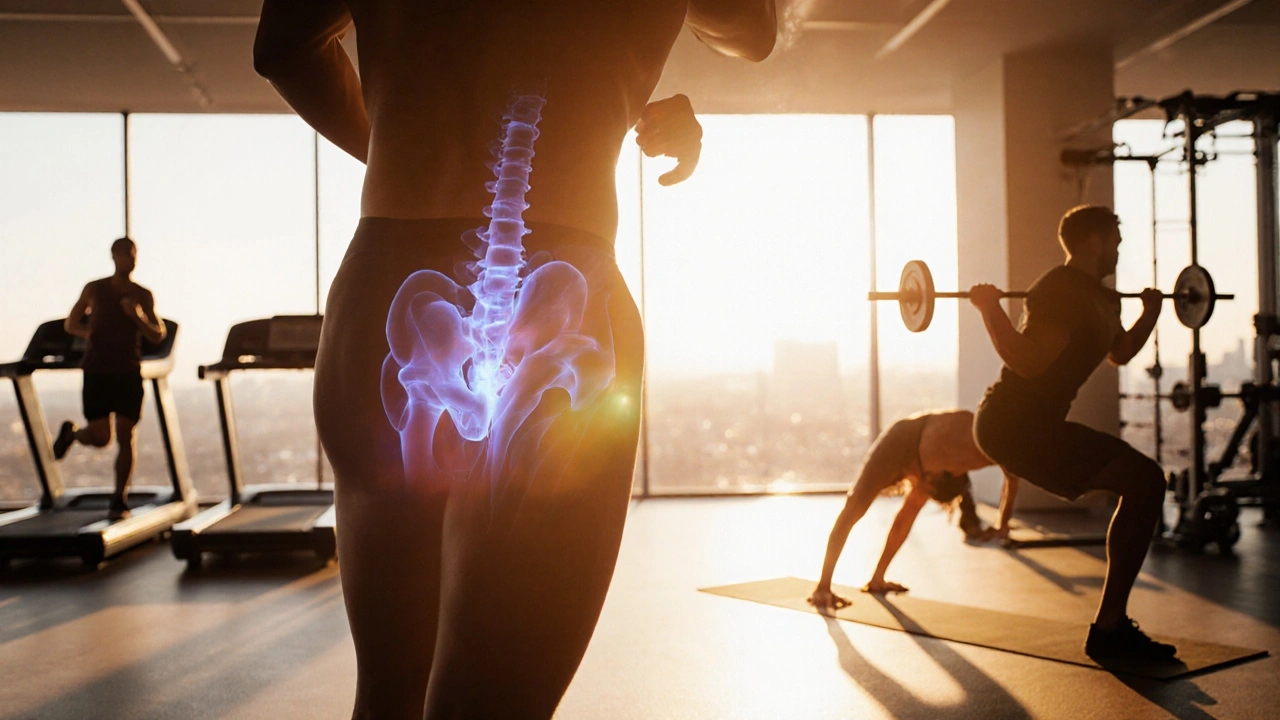How Exercise Affects Penis Enlargement: Facts & Myths

Penis Health Progress Estimator
Your Exercise Routine
Select your current exercise habits to estimate potential benefits
Key Takeaways
- Exercise can improve blood flow and hormone levels, which are essential for erection quality, but it does not dramatically increase length.
- Kegel and pelvic‑floor workouts strengthen muscles that support erections, offering modest girth gains for some men.
- Aerobic activities boost cardiovascular health, indirectly helping erectile firmness.
- Weight‑training and high‑intensity interval training may raise testosterone, yet the effect on size is limited.
- Safety matters: over‑exertion, improper technique, or reliance on unproven gadgets can cause injury.
When it comes to penis enlargement is the process of increasing the length or girth of the male genital organ through natural or medical methods, many men wonder if a workout routine can make a difference. The short answer is that exercise can enhance the factors that shape erection quality-blood flow, muscle tone, and hormone levels-but it rarely adds permanent length. Below we break down the biology, the exercises that get the most attention, what real studies say, and how to build a safe, realistic routine.
How Exercise Influences Penis Physiology
The penis itself is not a muscle, but it is surrounded by a web of smooth muscle, vascular tissue, and the pelvic floor muscles that control rigidity. Three physiological pillars determine how big a penis appears during an erection:
- Blood flow: An erection is a hydraulic event. When arteries dilate, blood rushes into the corpora cavernosa, and veins close off to trap it.
- Muscle tone: The ischiocavernosus and bulbospongiosus muscles compress the base of the penis, helping maintain pressure.
- Hormonal environment: Testosterone fuels libido and supports the health of erectile tissue.
Regular exercise can improve each of these pillars. Cardiovascular workouts enhance endothelial function, allowing arteries to widen more easily. Strength training and targeted pelvic‑floor work increase muscle tone that pushes blood into the shaft. Certain workouts also stimulate short‑term spikes in testosterone, which may improve libido and erection firmness.
Types of Physical Activities Often Linked to Penis Size
Not all workouts are created equal. Here are the four categories that show up most often in discussions about penis enlargement.
- Kegel (pelvic‑floor) exercises: Repeated contractions of the bulbocavernosus and ischiocavernosus muscles. When practiced correctly, they can increase erection rigidity and, for some men, add a few centimeters of girth over months.
- Aerobic/ cardio training: Running, cycling, swimming, or brisk walking improves blood flow throughout the body, including the penile arteries. Better circulation translates to stronger, longer‑lasting erections.
- Weight training & high‑intensity interval training (HIIT): Compound lifts (squat, deadlift, bench press) and short, intense bursts can raise baseline testosterone levels. The hormonal boost is modest but can help maintain healthy erectile tissue.
- Yoga & stretching routines: Poses like the ‘Cobra’ or ‘Bridge’ stretch the pelvic region, improve flexibility, and promote relaxation-factors that indirectly support erectile function.

What the Science Says
Scientific literature on exercise‑induced penis growth is limited, but several studies shine light on the real effects.
Study 1 - Kegel training: A 2014 clinical trial involving 50 men aged 30‑55 showed that a 12‑week Kegel program increased average girth by 0.6cm and improved International Index of Erectile Function (IIEF) scores by 20%.
Study 2 - Aerobic exercise: Researchers at the University of Texas followed 120 men who added 150minutes of moderate‑intensity cardio per week. After six months, penile arterial inflow (measured by penile Doppler) improved by 15%, and self‑reported erection firmness rose significantly, though length remained unchanged.
Study 3 - Resistance training: A 2020 meta‑analysis of 9 trials found that men who performed regular weight‑lifting experienced a 5‑10% rise in serum testosterone, yet no study demonstrated a direct increase in penile dimensions.
The consensus: exercises enhance erection quality, and some targeted pelvic‑floor work can add modest girth, but true length gains are rare without surgical or medical intervention.
Safety, Limits, and Common Pitfalls
Understanding the boundary between benefit and harm is crucial.
- Over‑doing Kegels: Excessive squeezing without relaxation can cause muscle fatigue, pain, or even erectile dysfunction.
- Improper cycling posture: Long rides on a hard saddle can compress the perineum, reducing blood flow and leading to numbness.
- Supplements and “pumps”: Many over‑the‑counter products claim dramatic size gains but lack credible evidence and may carry side‑effects.
- Expectations: A realistic target is improved firmness and possibly 0.5‑1cm of girth; any claim of several inches of growth from exercise alone is likely false.
Always warm up, cool down, and listen to your body. If you feel persistent pain, bruising, or loss of sensation, stop the routine and consult a urologist.
Building a Practical Routine
The goal is a balanced program that supports cardiovascular health, hormone balance, and pelvic‑floor strength. Below is a simple weekly plan that fits into most schedules.
- Cardio (3×week): 30‑minutes of brisk walking, jogging, or swimming at 60‑70% of max heart rate.
- Strength training (2×week): Full‑body compound lifts - squat, deadlift, bench press - 3sets of 8‑10 reps. Include a short HIIT finisher (e.g., 4×20seconds sprint, 40seconds rest).
- Kegel series (daily):
- Identify the right muscles by stopping urine flow mid‑stream.
- Contract for 5seconds, relax for 5seconds - repeat 10 times.
- Progress to 10‑second holds after two weeks.
- Yoga stretch (2×week): 10‑minute flow focusing on hip flexors, lower back, and pelvic opening - Cobra, Bridge, and Pigeon pose.
- Recovery: Ensure 7‑9hours of sleep, stay hydrated, and maintain a protein‑rich diet to support muscle repair.
Stick with the program for at least 12weeks before evaluating changes. Track erection firmness using a simple visual analog scale (1‑10) to see trends.

Myth‑Busting Corner
There’s a lot of hype surrounding “miracle” workouts. Here are the most persistent myths and the facts behind them.
- Myth: “Running a marathon will double your length.” Fact: Endurance running improves vascular health but does not stretch penile tissue.
- Myth: “The ‘balloon pump’ works without surgery.” Fact: Vacuum devices can temporarily increase girth for an erection but do not produce permanent growth.
- Myth: “Weight loss alone grows the penis.” Fact: Reducing fat around the pubic bone can make the organ appear longer, but the actual size stays the same.
- Myth: “More Kegels = bigger penis.” Fact: Consistency and correct technique matter; over‑training leads to fatigue, not size.
Frequently Asked Questions
Can regular cardio make my penis permanently larger?
Cardio improves blood flow, which can enhance erection hardness and make the penis appear larger during an erection, but it does not increase actual length.
How long does it take to see results from Kegel exercises?
Most men notice improved firmness after 4‑6weeks of consistent daily practice; modest girth gains may appear after 3‑4months.
Will lifting weights raise my testosterone enough to affect penis size?
Weight training can boost testosterone by 5‑15% in the short term, which supports erectile health but does not cause measurable length growth.
Are there risks to doing Kegel exercises wrongly?
Yes. Over‑contracting or failing to relax can lead to pelvic‑floor fatigue, pain, or temporary erectile difficulty. Start slow and focus on proper technique.
What’s the best combination of exercises for overall penis health?
A mix of moderate cardio (3×week), full‑body strength training (2×week), daily Kegels, and regular pelvic‑opening yoga offers the most balanced benefits for blood flow, muscle tone, and hormone support.
Comparison of Exercise Types for Penis Health
| Exercise | Primary Benefit | Typical Session | Evidence Level | Risk Profile |
|---|---|---|---|---|
| Kegel / Pelvic‑floor | Increased girth & firmness | 10‑15min daily | Moderate (clinical trials) | Low (muscle fatigue if over‑done) |
| Aerobic cardio | Enhanced blood flow | 30‑45min, 3×week | High (large population studies) | Low (joint stress if high impact) |
| Weight training / HIIT | Testosterone boost | 45‑60min, 2×week | Moderate (meta‑analysis) | Medium (injury if form poor) |
| Yoga / Stretching | Pelvic flexibility & relaxation | 10‑15min, 2×week | Low (small pilot studies) | Very low |
Remember, the penis enlargement journey is less about miraculous growth and more about creating conditions where the organ functions at its best. Combine science‑backed workouts with a healthy lifestyle, and you’ll likely see noticeable improvements in confidence and performance.
Ah, the age‑old quest for augmenting nature, a pursuit as timeless as the Greeks pondering the ideal form, yet as modern as a Fitbit tracking each heartbeat; we stand at the crossroads of biology and belief, where exercise, hormones, and sheer will converge, and one must ask: does the act of flexing the pelvic floor truly sculpt the very instrument of virility? The literature whispers of enhanced blood flow, of modest girth gains, of the humble Kegel-a modest contraction that, when performed with disciplined regularity, can coax the cavernous bodies into a more steadfast rigidity. Yet the mythic promises of inch‑gaining marathons belong firmly in the realm of fantasy, a Siren song for the insecure, amplified by questionable marketers and dubious “pump” devices. Consider, dear reader, the vascular principle: arteries dilate, blood surges, the penis becomes a hydraulic column; any regimen that improves endothelial health-be it brisk walking, measured sprints, or even the occasional squat-will inevitably improve that column’s stature during erection, though not its baseline length. Moreover, the hormonal axis, subtly nudged by resistance training, may elevate testosterone fleetingly, providing a boost to libido and perhaps the tone of the supporting musculature, yet the molecule itself does not rewrite the genetic blueprint of penile dimensions. In short, the prudent path lies not in chasing impossible magnitudes but in fostering overall cardiovascular vigor, targeted pelvic‑floor conditioning, and a balanced diet; the result is a healthier, more confident performance, not a miracle extension. Remember, over‑zealous Kegel sessions can backfire, causing fatigue or even temporary dysfunction, so moderation is key. Ultimately, the pursuit of “enlargement” is best reframed as the pursuit of optimal function. 🚀😊 When you adopt a routine that blends cardio, strength, and pelvic‑floor work, you lay the groundwork for improved nitric oxide production, a critical mediator of vasodilation. Consistency over weeks, not days, is the secret sauce, as adaptations accrue gradually. Be wary of anecdotal forums that tout “10‑minute miracle protocols” - the human body does not honor shortcuts. If you experience persistent pain, numbness, or erectile difficulty, seek professional counsel before persisting. In the grand tapestry of male health, exercise is but one thread, yet a vital one that intertwines with sleep, nutrition, and mental well‑being. Stay informed, stay skeptical, and above all, stay active in the pursuit of genuine health.
Great summary-consistent pelvic work and cardio really are the foundation for healthier function.
I appreciate the balanced tone; it’s refreshing to see a post that acknowledges both the potential benefits and the limits without slipping into hype. The emphasis on vascular health aligns with what we know from cardiology, and the caution about over‑doing Kegels is spot‑on. For anyone new to this, start slow and track progress, perhaps with a simple scale, to avoid frustration. 😊
Exactly! Mixing a few runs with daily Kegels is doable even on a busy schedule, and the confidence boost you get from a firmer erection is priceless. Keep it up, and you’ll notice the difference in weeks, not months.
Honestly, I’ve seen too many “miracle” videos promising inches overnight-suspicious stuff, probably funded by shady supplement companies. The science is clear: no quick fix, just hard‑earned progress. Don’t fall for the hype.
The whole “grow a few centimeters by doing Kegels” saga feels like a modern myth, a narrative sold to insecure men; yet the data whisper otherwise-tiny gains at best, while the real story is about confidence and blood flow.
From a hermeneutic perspective, the discourse surrounding corporeal augmentation through somatic exertion can be situated within the broader ontological debate concerning the malleability of phenotypic expression under extrinsic stimuli. The extant corpus of urological scholarship delineates a tripartite framework-hemodynamic optimization, myogenic reinforcement, and endocrinological modulation-as the principal axes of functional enhancement. Within this schema, aerobic conditioning operates as a catalyst for endothelial nitric oxide synthase up‑regulation, thereby augmenting vasodilatory capacity in the penile vasculature. Concurrently, resistance training precipitates acute anabolic surges, predominantly via the mechanistic target of rapamycin (mTOR) pathway, which may subtly influence androgenic milieu yet remains insufficient to provoke macroscopic dimensional alteration. Pelvic‑floor musculature, when subjected to structured isometric contractions, engenders a supportive scaffolding effect that amplifies intracavernosal pressure retention, a phenomenon corroborated by Doppler ultrasonography studies. However, the epistemic gap persists regarding longitudinal morphological changes; most randomized controlled trials report statistically significant improvements in erectile rigidity indices but negligible shifts in flaccid or erect length metrics. It is incumbent upon the practitioner to disseminate this nuanced understanding, eschewing reductionist rhetoric that conflates vascular health with irreversible tissue elongation. Moreover, the psychosexual ramifications of perceived enhancement merit rigorous examination, as the placebo effect can potentiate subjective satisfaction independent of physiological modification. In synthesis, a multimodal regimen-encompassing moderate‑intensity cardiovascular intervals, progressive resistance protocols, and calibrated pelvic‑floor training-constitutes the empirically substantiated approach to optimizing erectile function, albeit without guarantee of substantive penile length accretion. Future investigational trajectories should prioritize longitudinal imaging modalities and biomarker profiling to elucidate any latent hypertrophic potential inherent within cavernous tissue. Until such data emerge, clinicians and laypersons alike must navigate the terrain of expectation with calibrated realism and methodological rigor.
Sure, the data are clear, but some people still chase myths.